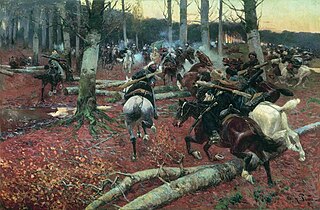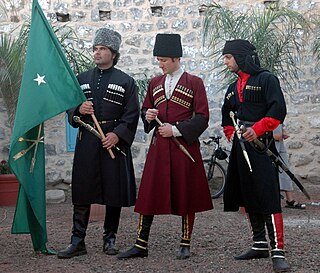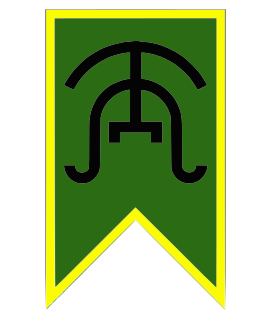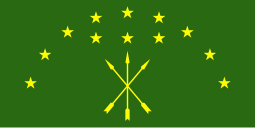
The Republic of Adygea, also known as the Adyghe Republic, is a federal subject of Russia. It is geographically located in the North Caucasus region of European Russia, and is part of the Southern Federal District. Adygea covers an area of 7,600 square kilometers (2,900 sq mi), the fifth-smallest Russian federal subject by area, with its territory an enclave within Krasnodar Krai. Adygea has a population of 439,996.

Circassia is a region in the North Caucasus and along the northeast shore of the Black Sea. It is the ancestral homeland of the Circassian people.

The Circassians, also known by their endonym Adyghe, are a Northwest Caucasian ethnic group native to Circassia, many of whom were displaced in the course of the Russian conquest of the Caucasus in the 19th century, especially after the Russo-Circassian War in 1864. The Circassians mainly speak the Circassian languages, a Northwest Caucasian dialect continuum with three main dialects and numerous sub-dialects. Many Circassians also speak Turkish, Russian, English, Arabic and Hebrew, having been exiled by Russia to lands of the Ottoman Empire, where the majority of them live today. Most Circassians are Sunni Muslim.

Adyghe, also known as West Circassian, is one of the two official languages of the Republic of Adygea in the Russian Federation, the other being Russian. It is spoken by various tribes of the Adyghe people: Abzekh, Adamey, Bzhedug, Hatuqwai, Temirgoy, Mamkhegh, Natekuay, Shapsug, Zhaney and Yegerikuay, each with its own dialect. The language is referred to by its speakers as Adygebze or Adəgăbză, and alternatively transliterated in English as Adygean, Adygeyan or Adygei. The literary language is based on the Temirgoy dialect.

Circassian, also known as Cherkess, is a subdivision of the Northwest Caucasian language family. There are two Circassian languages, defined by their literary standards, Adyghe, with half a million speakers, and Kabardian, with a million. The languages are mutually intelligible with one another, but differ to a degree where they would be considered clear-cut dialects. The earliest extant written records of the Circassian languages are in the Arabic script, recorded by the Turkish traveller Evliya Çelebi in the 17th century.
The Ubykh are one of the twelve Circassian tribes, representing one of the twelve stars on the green-and-gold Circassian flag. Along with the Natukhai and Shapsug tribes, the Ubykh were one of three coastal Circassian tribes to form the Circassian Assembly in 1860. Historically, they spoke a distinct Ubykh language, which never existed in written form and went extinct in 1992 when Tevfik Esenç, the last speaker, died.

The Kabardians, or Kabardinians, are the largest of the twelve Adyghe (Circassian) tribes. They are also commonly known by the plural terms Kabardin, Kebertei, or Kabarday. Along with the Besleney tribe, they speak a distinctive dialect of the Adyghe language.

The Caucasian War of 1817–1864 was an invasion of the Caucasus by the Russian Empire which resulted in Russia's annexation of the areas of the North Caucasus, and the ethnic cleansing of Circassians. It consisted of a series of military actions waged by the Empire against the peoples of the Caucasus including the Adyghe, Abkhaz–Abaza, Ubykhs, Kumyks and Nakh and Dagestanians as Russia sought to expand. In Dagestan, resistance to the Russians was described as jihad.

The Shapsug, also known as the Shapsugh or "Shapsogh", are one of the twelve tribes of the Circassian people. In Russia, the remaining Shapsug population mainly live in the Tuapsinsky District (Tuapse) of Krasnodar Krai, Lazarevsky City District of Sochi, and in the Republic of Adygea, which were a small part of historical Circassia. However, the major Shapsug communities are found in Turkey, Israel, Jordan, Iraq, Syria, Western Europe, and the United States of America. The first Circassians to settle in Amman were from the Shapsug tribe, and as a result the Shapsug's neighbourhood is considered the oldest neighbourhood in the Capital Amman and was the down town of it; however, other Circassians from the Kabardian, Abadzekh, and Bzhedug tribes also settled in Amman afterwards.

The Circassian genocide was the Russian Empire's ethnic cleansing, killing, forced migration, and expulsion of the majority of the Circassians from their historical homeland Circassia, which roughly encompassed the major part of the North Caucasus and the northeast shore of the Black Sea. This occurred in the aftermath of the Caucasian War in the last quarter of the 19th century. The displaced people moved primarily to the Ottoman Empire.
The Abzakh, also known as Abdzakhs or Abadzekhs, are one of the twelve Adyghe tribes of the Circassian people. After Kabardians, the Abzakh are the second largest Adyghe tribe in Turkey, other diaspora countries, and in the world in general. They are also the second largest Adyghe tribe in Israel, largest in Jordan, and the sixth largest in Russia.
The Russo-Circassian War (1763–1864) involved a series of battles and wars in Circassia, the northwestern part of the Caucasus, during the course of the Russian Empire's conquest of the Caucasus. Those who use the term Russian–Circassian War take its starting date as 1763, when the Russians began establishing forts, including at Mozdok, to be used as springboards for conquest; and only ending approximately 101 years later, with the signing of loyalty oaths by Circassian leaders on 2 June [O.S. 21 May] 1864. The alternative term used, the Caucasian War, commonly refers only to the period 1817–1864.

The flag of Kuban is a horizontal tricolour of blue, purple, and green. The purple band is twice the width of the other two. The flag was adopted by Kuban Parliament on 10 February 1919 as the national and state flag of the Kuban People's Republic. The colours symbolise unity of three principal social-ethnic groups of Kuban society: majority - Cossacks /purple/, autochthonous - Circassians (Adyghe) /green/, and minority - all others /blue/.

Circassian nationalism is the desire among Circassians to reestablish an independent Circassian state in Circassia, which lost its independence in the Russian–Circassian War. Many of its themes involve the repatriation of diaspora Circassians and the revitalization of the Adyghe language.

Circassians in Israel refers to the Circassian people who live in Israel. They hail from a Northwest Caucasian ethnic group native to Circassia who mostly adhere to Islam.

The Besleney, also known as Beslenei or Baslaney, are one of the twelve tribes of the Circassian (Adyghe) people. It was named after Kabardian Prince Beslan who established his own tribe of the same name.

Sefer Bey Zanuko was a Circassian nobleman and independence activist. He took part in the various stages of the Russo-Circassian War both in a military and a political capacity. Advocating for the cause of Circassian independence in the west and acting as an emissary of the Ottoman Empire in the region. By the end of his life Zanuko had emerged as the leader of the Circassian independence movement.

House of Tkhaghapseu is a Circassian house of peasant origin of Shapsug Princedom of Circassia. They are said to be one of the four largest houses of Circassians in terms of population. They are found all over the historical Circassia in the present day, in Adygea, Krasnodar Krai, Karachay-Cherkessia and Kabardino-Balkaria; as well as in Republic of Turkey and Hashemite Kingdom of Jordan due to Circassian Genocide.

House of Kuadzhe or Quadzhe, is a Circassian house of peasant and privateer origin of Shapsug Princedom of Circassia. It actively supported Circassia during the Russo-Circassian War and was dispersed throughout Ottoman Empire due to the mass expulsion of Circassians and the Circassian genocide. In the present day, members of the house can be found throughout the Tuapsinsky District, Krasnodar Krai, Russia and Republic of Turkey.

House of Chetao is a Circassian knightly house of Abdzakh Princedom of Circassia. They are found in Republic of Adygea and Krasnodar Krai, Russian Federation; as well as in Republic of Turkey, Syrian Arab Republic, Hashemite Kingdom of Jordan and Republic of Iraq due to Circassian Genocide in present day.















